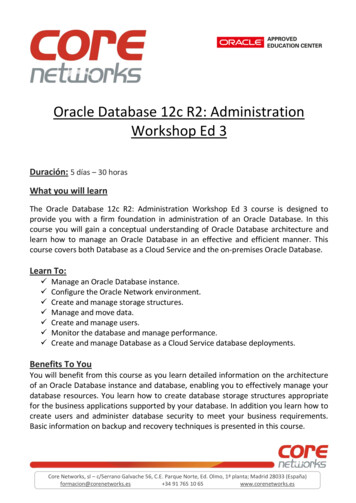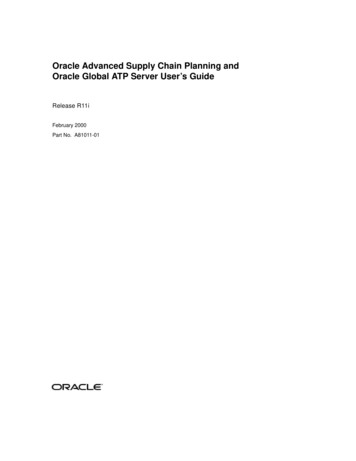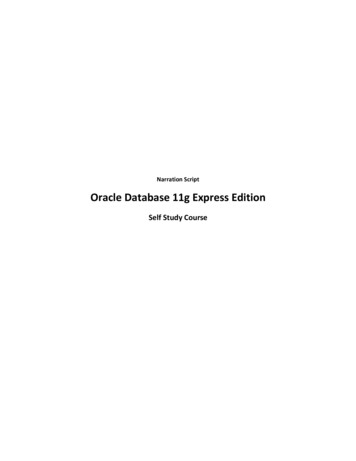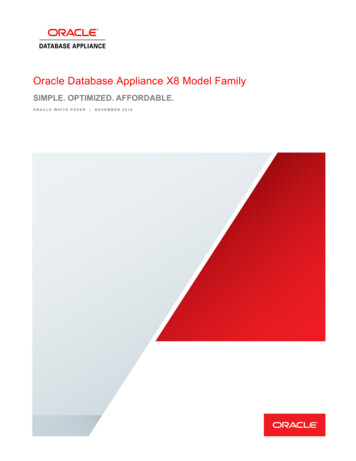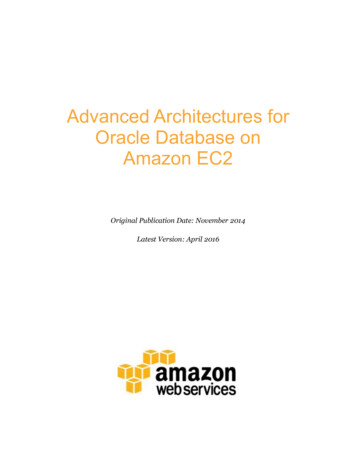
Transcription
Advanced Architectures forOracle Database onAmazon EC2Original Publication Date: November 2014Latest Version: April 2016
2016, Amazon Web Services, Inc. or its affiliates. All rights reserved.NoticesThis document is provided for informational purposes only. It represents AWS’scurrent product offerings and practices as of the date of issue of this document,which are subject to change without notice. Customers are responsible formaking their own independent assessment of the information in this documentand any use of AWS’s products or services, each of which is provided “as is”without warranty of any kind, whether express or implied. This document doesnot create any warranties, representations, contractual commitments,conditions or assurances from AWS, its affiliates, suppliers or licensors. Theresponsibilities and liabilities of AWS to its customers are controlled by AWSagreements, and this document is not part of, nor does it modify, any agreementbetween AWS and its customers.
ContentsIntroduction1Oracle Database Editions and License Implications for AWS1Oracle License Portability to AWS3Oracle Database AMIs3Architecting for Security and Performance4Network Deployment4Amazon EC2 Instance Type Selection4Storage5Advanced Architectures5Standard Architecture7Enterprise-Class Architecture7Large Enterprise-Class Architecture8High-Performance Architecture9Oracle RAC Architecture10Contributors11Further Reading12
AbstractAmazon Web Services (AWS) provides a comprehensive set of services and toolsfor deploying Oracle Database on the reliable and secure AWS cloudinfrastructure. You can use the inherent qualities of the AWS cloud, such as itsinstant provisioning, scalability, elasticity, and geographic footprint, to architecta highly resilient and performant database environment for demandingbusiness applications. This whitepaper provides information on how to buildadvanced Oracle Database architectures in the AWS cloud.
Amazon Web Services – Advanced Architectures for Oracle Database on Amazon EC2IntroductionAWS customers can run Oracle Database on Amazon Relational DatabaseService (Amazon RDS), the fully managed database service in the cloud, andalso directly on Amazon Elastic Compute Cloud (Amazon EC2). Each of theseoptions offers distinct advantages.Amazon RDS is a fully managed service that makes provisioning andmanagement of Oracle databases very easy. Amazon RDS makes it simple to setup, operate, and scale a relational database in the cloud by automatinginstallation, disk provisioning and management, patching, minor versionupgrades, failed instance replacement, backup, and recovery. The Multi-AZ(Availability Zone) feature of Amazon RDS operates two databases withsynchronous replication, creating a highly available environment withautomatic failover. The push-button scaling feature of Amazon RDS allows youto easily scale up and scale down an instance for better cost management andperformance. Amazon RDS also comes with a license-included option, allowingyou to pay for use by the hour. Amazon RDS for Oracle is a great option formany enterprise workloads, from development and test environments, toproduction systems that use enterprise applications (such as PeopleSoft, JDEdwards, and Seibel), to custom-built applications that use Oracle Database onthe back end.Amazon EC2, in contrast, allows you full control over setup of the entireinfrastructure and database environment when you run Oracle Databasedirectly on it. Running a database on Amazon EC2 is very similar to running adatabase on your own server. You can have full control of the database andaccess at the operating system level. This control and access allows you to runmonitoring and management agents and use your choice of tools for datareplication, backup, and restoration. It also lets you use additional optionsavailable with Oracle Database Enterprise Edition.Oracle Database Editions and LicenseImplications for AWSOracle Database is available in four editions. As of the date of this whitepaper,Oracle licensing policies allow all four editions to be used on AWS, but usersshould confirm the specifics of their license agreement. The Express, StandardPage 1
Amazon Web Services – Advanced Architectures for Oracle Database on Amazon EC2One, and Standard editions each have certain limitations compared toEnterprise Edition. There can also be a substantial price difference among thelicenses for the different editions. Express Edition is not usually used by businesses for productionpurposes, due to its size and processor limitations. Standard One Edition and Standard Edition both have a limitation on thenumber of processors that can be used and the additional options andfeatures available, such as partitioning, online index rebuild, parallelquery/transaction, advanced security, advanced compression, and so on.These editions are equivalent to Enterprise Edition in all other respects. Enterprise Edition does not have the limitations of the other editions, hasall Oracle Database options available to it, and is widely used inenterprise production systems.For information on Oracle Database licensing, go to the Licensing OracleSoftware in the Cloud Computing Environment document on the Oraclewebsite.1 A few key points: The virtual core count of Amazon EC2 instances is considered equal tothe physical core count for licensing purposes. To find out the virtualcore count of each Amazon EC2 instance type, refer to the Amazon EC2virtual core web page.2 Oracle Database Standard Edition may only be licensed on Amazon EC2instances up to 16 virtual cores. Oracle Standard Edition One and Standard Edition Two may only belicensed on Amazon EC2 instances up to 8 virtual cores. For Standard Edition, Standard Edition One, or Standard Edition Two,Amazon EC2 instances with 4 or less virtual cores are counted as onesocket. For Enterprise Edition, Amazon EC2 instances with 2 or less virtual coresare counted as one socket.Any discussion of Oracle licensing policies and costs in this whitepaper is forinformational purposes only and is based on the information available at thetime of writing. Users should consult their own Oracle license agreement formore specific information.Page 2
Amazon Web Services – Advanced Architectures for Oracle Database on Amazon EC2Oracle License Portability to AWSSubject to the terms and conditions of the specific license agreement, Oraclelicenses may be portable to AWS. In other words, your existing licenses can betransferred for use on AWS. These include: Server-based licenses (based on CPUs used) Enterprise License Agreements (ELA) Unlimited License Agreements (ULA) Business Process Outsourcing (BPO) licenses Oracle Partner Network (OPN) licenses Named User Plus licensesAdditional conditions or limitations (including possible costs) may be applicablefor licenses that are ported to AWS. Users should check their specific licenseagreement for additional details and limitations.Oracle Database AMIsOracle has periodically provided official Amazon Machine Images (AMIs) forOracle Database on AWS. However, the AMIs available might not be for theversion of Oracle Database that you need. Oracle AMIs are provided only foryour convenience; you actually don't need an Oracle AMI to install and useOracle Database on AWS. If you don't find an AMI with the latest databaseversion, you can start an Amazon EC2 instance with an operating system AMIand then download and install Oracle Database software from the Oraclewebsite, just as you would with a physical server. An AMI of any one of the fourOracle-certified operating systems can be used for this purpose. Oracle-certifiedoperating systems available on AWS are Red Hat Enterprise Linux, OracleLinux, SUSE Linux Enterprise Server, and Microsoft Windows Server.Once you have the first environment set up with all the Oracle binary files, youcan create your own custom AMI for subsequent installations. Oracle DatabaseAMIs created by third parties are also available on AWS Marketplace, which canbe directly launched as needed. Any community AMIs provided by third partiesshould be closely scrutinized for security and reliability before use, and AWS isnot responsible or liable for their security or reliability.Page 3
Amazon Web Services – Advanced Architectures for Oracle Database on Amazon EC2Architecting for Security and PerformanceOptimizing every component of your database infrastructure will enhancesecurity, performance, and reliability. Let's look at each of the components thatwill be used in an Oracle Database implementation on Amazon EC2 from thatpoint of view.Network DeploymentAWS users are encouraged to use an Amazon Virtual Private Cloud (AmazonVPC) for the database instances. Using an Amazon VPC provides isolation,additional security, the ability to separate Amazon EC2 instances into subnets,and the ability to use private IP addresses. All of these are important when itcomes to database implementation. Deploy the Oracle Database instance in aprivate subnet and allow only application servers within the VPC or a Bastionhost within the VPC to access the database instance. In addition, createappropriate security groups that allow access only to specific IP addressesthrough the designated ports.Amazon EC2 Instance Type SelectionIt is very important to choose the right Amazon EC2 instance type for yourdatabase. AWS makes many different instance types available to allowcustomers to choose the right type of instance for their workload. Very smallinstance types are not suitable for Oracle databases, because an Oracle databaseis resource-intensive when it comes to CPU usage.Instances with a larger memory footprint improve database performance byproviding better caching and bigger system global area (SGA). Thus, it's a goodidea to choose instances that have a good balance of memory and CPU.Oracle Database heavily uses disk storage for read/write operations, so wehighly recommend using only Amazon EC2 instances optimized for AmazonElastic Block Store (Amazon EBS). Amazon EBS–optimized instances deliverdedicated throughput between Amazon EC2 and Amazon EBS. Bandwidth andthroughput to the storage subsystem is crucial for good database performance;choose instances with higher network performance for better databaseperformance.Page 4
Amazon Web Services – Advanced Architectures for Oracle Database on Amazon EC2StorageFor database storage, AWS users are encouraged to use Amazon EBS. For highand consistent IOPS, we highly recommend using General Purpose (GP2)volumes or Provisioned IOPS (PIOPS) volumes. GP2 can provide up to 10,000IOPS per volume, and PIOPS can provide up to 20,000 IOPS per volume. GP2volumes provide an excellent balance of price and performance for mostdatabase needs. When very high IOPS is required, PIOPS volumes are the rightchoice.Stripe multiple volumes together for more IOPS and larger capacity. You canuse multiple Amazon EBS volumes individually for different data files, butstriping them together allows better balancing and scalability. Oracle AutomaticStorage Management (ASM) can be used for striping. Keep data files, log files,and binaries on separate EBS volumes, and take snapshots of log file volumeson a regular basis. Choosing an instance type with local SSD storage allows youto boost the database performance by using Smart Flash Cache (if the operatingsystem is Oracle Linux) and by using local storage for temporary files and tablespaces.Most Oracle Database users take regular hot and cold backups. Cold backupsare done while the database is shut down, whereas hot backups are taken whilethe database is active. Store your hot and cold backups in Amazon SimpleStorage Service (Amazon S3) for high durability and easy access. AmazonStorage Gateway or Oracle Secure Backup Cloud Module can be used to directlyback up the database to Amazon S3. Life-cycle policies can be applied to thebackups in Amazon S3 to move older backups to Amazon Glacier for archiving.Advanced ArchitecturesHow organizations use Oracle Database varies heavily from implementation toimplementation. In some cases, a database is used for online transactionprocessing (OLTP) loads with very high performance requirements. In othercases, a database is used as part of business-decision support systems that usevery large databases with high reliability requirements and less stringentperformance expectations. In another scenario, a moderate-sized database runsbusiness applications where high availability and load distribution are the mostcritical criteria. A fourth scenario combines all the requirements mentioned andincludes reliability, high availability, and high performance, as well as scalabilityPage 5
Amazon Web Services – Advanced Architectures for Oracle Database on Amazon EC2and load distribution. Then there are small databases used throughoutenterprises for various repositories, custom applications, and reporting. Thesescenarios constitute the vast majority of use cases for Oracle Database in mostbusinesses. In the rest of the whitepaper, we will discuss five architectures forOracle Database implementation on AWS that will fit very well with the fivescenarios discussed above.All the architectures discussed here include a disaster recovery (DR)component. Because a database is a crucial piece of any enterprise businesssystem, it is important to have protection to make sure data is safe andrecoverable, especially when unexpected things happen. Each architecturediscussed here uses a distinct disaster recovery pattern based on the theme ofthe overall architecture. Depending on your objectives for recovery time andrecovery point, you can mix and match the primary database and disasterrecovery architectures to fit your needs. For details on these disaster recoverypatterns, see the whitepaper Using Amazon Web Services for DisasterRecovery.3The following discussion puts the architectures in order of increasing levels ofcapability, complexity, and cost. With each of the following architectures, AWSusers may employ additional tools such as reserved instances and volumediscounts to optimize the cost of your implementation.Page 6
Amazon Web Services – Advanced Architectures for Oracle Database on Amazon EC2Standard ArchitectureThe standard architecture shown below is a general-purpose databasedeployment with a good balance of cost and performance, optimized for loweroverall cost. This architecture is adequate for many software development andtest environments, small application deployments in production environments,custom projects, and reporting systems. You can perform data backup either byusing EBS snapshots to Amazon S3 or using Oracle Recovery Manager (RMAN)and Oracle Secure Backup Cloud Module (OSB). Although this architecture isdeployed as a simple, small design, it is highly scalable and can be migrated toanother of the architectures described below as requirements change.We recommend this architecture for database sizes up to 1 TB with up to amaximum of 3000 IOPS. Although this architecture is the simplest one, a verylarge percentage of Oracle databases fall into this category, because the numberof databases used for development and test and small projects in any enterprisecomes to a sizeable number.Enterprise-Class ArchitectureFor many enterprises, availability and reliability of the database on which theirbusiness applications run is crucial, because database downtime can result inlost business and in compliance and policy violations. The enterprise-classarchitecture shown below puts emphasis on high availability and reliability. Ithas an excellent balance of performance, high availability, and fault tolerance.This architecture can be used for large databases for enterprise applications thatneed enterprise-class performance and reliability. Based on your needs, the sizeof the Amazon EC2 instance chosen to run this architecture can vary, but biggerPage 7
Amazon Web Services – Advanced Architectures for Oracle Database on Amazon EC2instances are recommended. Because Oracle Data Guard is used for replication,the Enterprise Edition license is required. However, this architecture can alsobe modified to use third-party tools that work with Standard Edition andStandard One Edition to provide the same functionality as Oracle Data Guard.This architecture differs in many key ways from the one we discussedpreviously. One very important difference is that it uses multiple GP2 EBSvolumes for the data files. Though it is possible to add and mount multiple EBSvolumes separately to use individually for data files, we recommend stripingacross the EBS volumes for much higher performance through cumulativeIOPS. Here, the database is backed up to Amazon S3 using RMAN and OSB. DRis implemented using a “backup and restore” pattern to keep the cost lower.Large Enterprise-Class ArchitectureThe large enterprise-class architecture builds on the previous enterprise-classone, distributing the load across multiple Availability Zones by using OracleActive Data Guard. The emphasis in this design is on enterprise-level reliability,Page 8
Amazon Web Services – Advanced Architectures for Oracle Database on Amazon EC2availability, and performance. This architecture is targeted at larger enterpriseworkloads with big databases and heavier processing requirements. In this case,we highly recommend that you use larger Amazon EC2 instances and stripedAmazon EBS PIOPS volumes for better performance. Replicating with ActiveData Guard means you can use the replicated standby instances for read-onlyloads, allowing some load distribution. This architecture also uses a “pilot light”disaster recovery pattern, ready to scale up at a moment’s notice, for quickerrecovery in a disaster recovery event.High-Performance ArchitectureThe high-performance architecture is designed primarily for very high I/Operformance. It leverages local (ephemeral) SSD drives to take advantage ofvery high IOPS and avoid network latency. Under certain conditions, AWS usersmay be able to achieve up to 340,000 IOPS and very high throughput using thisarchitecture.This architecture uses ephemeral instance storage for the database; standbyinstance storage is based on EBS volumes for data safety and reliability. Thisarchitecture also performs replication to another instance in the same or adifferent Availability Zone using Oracle Active Data Guard. If the primaryPage 9
Amazon Web Services – Advanced Architectures for Oracle Database on Amazon EC2instance fails, this architecture rapidly switches over to the second instance inthe same Availability Zone, making the database continuously available andpreventing data loss. In a case where either the primary Availability Zone failsor both the primary and secondary instances fail, then this architecture switchesover to a third instance in a secondary Availability Zone, thus keeping thedatabase available and preventing data loss. Use of Active Data Guard forreplication allows the second and third instances to be simultaneously used forread-only workloads, facilitating load distribution.The maximum size of the database possible using this architecture is limited tothe maximum size of SSD-based instance storage available for that particularinstance type. When you consider database size for this architecture, alsoconsider storage for log files and for a flash recovery area. Any instance typewith a good balance of CPU power and memory that has local SSDs can be usedto implement this architecture. However, the instance type best suited for thisarchitecture is the I2 group of Amazon EC2 instances.Oracle RAC ArchitectureThe Oracle Real Application Clusters (RAC) architecture is a shared-everythingdatabase cluster architecture. Oracle RAC allows a single database (a set of datafiles) to be concurrently accessed and served by one or many database serverinstances.Page 10
Amazon Web Services – Advanced Architectures for Oracle Database on Amazon E
Enterprise Edition does not have the limitations of the other editions, has all Oracle Database options available to it, and is widely used in enterprise production systems. For information on Oracle Database licensing, go to the Licensing Oracle Software in the Cloud Computing Envir



